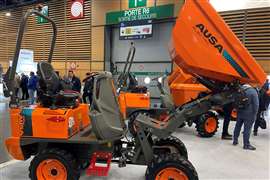Lifting people is the subject of new guidelines
02 August 2011

Represented by the FEM, crane manufacturers have set out their position on using their products to lift people.
The European materials handling and lifting equipment federation, FEM, issued a position paper on 16 May 2011 on the use of mobile cranes to lift people.
According to the Fédération Européenne de la Manutention (FEM) cranes and lifting equipment product group mobile cranes sub-group, mobile cranes shall never be used for entertainment purposes. That includes lifting people for shows, bungee jumping, dinner-in-the-sky or lifting of other structures with people on, or underneath, that structure.
The paper, document FEM CLE MC N 0284, continues, "Mobile cranes are not intended to lift persons; they may be used to hoist and suspend personnel in man baskets only in unique work situations when it is the least hazardous way to do the job. Platforms fixed to crane booms for lifting of persons are not included herewith, as they are covered by international standards for mobile elevated work platforms [MEWP]."
Most, if not all, crane associations fully agree with and support the FEM position. It was discussed at the International Crane Technical Liaison meeting in Las Vegas, USA, during the ConExpo trade show in March 2011. It is in alignment with similar statements from other mobile crane manufacturer organisations outside Europe.
The paper was also discussed during the European Association of Abnormal Road Transport and Mobile Cranes (ESTA) crane section meeting in Amsterdam, the Netherlands, on 7 June. Health and safety executives across Europe have had different opinions on the possibility of crane owners using man baskets. In some countries it is strictly forbidden while in others it is allowed under certain conditions.
The FEM position paper was sent to MACHEX, a committee representing European health and safety executives, asking them to discuss a European harmonisation of the rules and requirements for the use of suspended man baskets in mobile cranes. As no common harmonised set of recommendations exists from the manufacturers, each country in Europe has its own legislation. Using this position paper, each European association can initiate discussions with their local health and safety executives to ask them to accept it.
FEM said that the exceptional use of cranes for lifting people is permitted only if every item in a list of requirements is fulfilled. Users are responsible as follows:
General
- The use of mobile cranes for lifting of persons is permitted by national law in the country of current operation. Specific provisions for the use of man baskets as stipulated by national law are applied.
- The use of the crane for lifting of persons is reported to the national health and safety authority, if needed by national law (the use may need special approval).
- The possibility to rescue people in the basket in cases of emergency has been evaluated prior to the job by means of a job-specific risk assessment. Provisions for emergency rescue have to be taken if stipulated by national law.
- A pre-lift meeting has been held involving all relevant people.
- The provisions for work in the vicinity of power lines according to the job site conditions and national laws and regulations are observed.
Equipment
- With the exception of the man basket being the load, the crane is used as intended and described in the respective operating manual.
- The crane is checked and no damages are found prior to lifting persons.
- The man basket is fulfilling the requirements according to national law and/or standards and is used as intended.
- The man basket is checked thoroughly, no defects are found prior to lifting persons.
- Any emergency rescue device, if required by national law, has been checked and found to be operational.
- Hooks used must be of a type that uses a latch eliminating the throat opening. According to national law it is required either to close and lock manually or to use a latch automatically closing operated by a spring.
Tests prior to use
Before lifting personnel, an overload test lift (proof test) with an overload of 125% of the rated capacity of the basket has been performed at each new construction site and after each modification or repair to verify the performance of basket and lifting attachment (relocation of a crane with basket on a bigger construction site does not create the need for additional overload testing).
Before lifting personnel, a trial lift with the unoccupied basket loaded at least to the anticipated lift weight to simulate the loaded basket has been performed simulating the complete planned lifting cycle. This trial lift has to be done at each set up location on a construction site where personnel handling is to be done.
Use
- The rope pull is limited to 50% of the maximum line pull.
- The crane is used at 50% of the maximum capacity of the relevant load chart.
FEM represents European manufacturers of material handling equipment, including lifting equipment and mobile cranes. For further information see: http://www.fem-eur.com/






